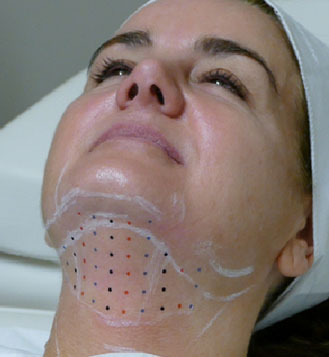
Few accomplishments are as rewarding as waking up in the morning and hitting your target weight. You've worked hard to drop those unwanted pounds all year long, and you deserve a huge round of applause for what you've accomplished. However, if you're like many men and women, getting the sleek, sculpted body you crave is easier said than done. You've got pockets of unwanted fat around your abdomen, thighs, chin, and other areas - fat that just won't go away, despite diet and exercise.
Wouldn't it be nice to just freeze that fat away and forget all about your love handles?
At Southern Cosmetic Laser, our new, revolutionary fat-freezing treatment can help you achieve the toned look you've been dreaming of. That's right - we're talking about literally freezing the unwanted fat off your problem areas without invasive surgeries or extended downtime.
This amazing treatment is called CoolSculpting, and it's the world's leading non-invasive fat reduction procedure. It's specifically designed for people already at their desired weight who want to push past that plateau for real body sculpting results. If you're tired of seeing that excess belly fat, saggy skin, or double chin, CoolSculpting is the procedure for you. Southern Cosmetic Laser offers a wide range of the newest technologies to target fat reduction, skin tightening, facial and body remodeling, body toning, and cellulite reduction.

Our Services
Services Area

What is CoolSculpting?

CoolSculpting is an FDA-approved procedure that has undeniable results. With CoolSculpting, you can permanently get rid of your muffin top, fat around your flanks, and more, all from the comfort and convenience of the Southern Cosmetic Laser office.
Technically known as cryolipolysis, CoolSculpting has the ability to reduce the number of fat cells in targeted areas between 20 and 25%. This unique technology uses controlled cooling to freeze and eliminate fat with minimal recovery time. No needles, no scalpels, no liposuction. Just real results provided by a licensed, experienced professional.
While CoolSculpting helps eliminate fat cells in your body, it doesn't harm the surrounding skin and muscles. Instead, it treats fat that is directly under the skin, also called subcutaneous fat. Since CoolSculpting doesn't target visceral fat deposits, this treatment works best for men and women who are approaching or already at their desired weight.
CoolSculpting is approved by the FDA to help reduce fat in the following areas:
- Flanks
- Outer Thighs
- Upper Arms
- Inner Thighs
- Chin
- Back
- Belly and Abdomen
How Does CoolSculpting Work?

CoolSculpting results are noticeable, proven, and long-lasting, helping you look your best and feel great from every angle. This exciting procedure works because fat cells freeze at higher temps than other tissues. As such, CoolSculpting delivers controlled, targeted cooling to do away with unwanted fat underneath your skin. These fat cells are essentially frozen or crystallized and eventually die. With time, your body will process that fat and will eliminate the dead cells, leaving behind a more sculpted physique.
Here are some quick CoolSculpting facts at a glance, so you have a better idea of why this fat cell elimination treatment is so popular:
- There is no prep time required for CoolSculpting from Southern Cosmetic Laser.
- Patients can expect some very minor discomfort during the procedure. Many patients report no discomfort at all.
- There is little-to-no downtime needed after your CoolSculpting procedure is complete.
- It may take up to 12-16 weeks to see your final results.
- This procedure eliminates fat permanently!

Southern Cosmetic Laser's CoolSculpting Procedure

Our CoolSculpting procedure is crafted around your comfort, with one-on-one attention in a relaxing atmosphere. It all starts with a detailed assessment, which you will complete prior to your treatment. This assessment will help us better understand your goals and desires, so we can freeze away the stubborn fat from the areas that matter most.
Typical CoolSculpting appointments take about an hour per area, though that time varies with each patient. Because our CoolSculpting applicators use a vacuum system to help with placement, you may feel a pulling sensation in the targeted area. Once placement is complete, we get to work on freezing your fat.
Before treatment, your skin is prepped with an alcohol wipe. A gel pad is then placed on your treatment area to help protect your skin. From there, a cold sensation is delivered through our applicators, which are designed for specific body parts.
Because there is no sedation involved with CoolSculpting, we encourage you to kick back, relax, and watch a little TV. If you prefer, you can also read or use your phone to check your favorite social media sites. Our friendly, experienced CoolSculpting technicians strive to keep you as comfy as possible during this quick treatment. When it's over, you can resume normal activities as soon as you like - there's no recovery or downtime to worry about!


Top CoolSculpting Treatment Areas

CoolSculpting procedures are perhaps best known for eliminating stubborn belly fat, giving the patient a desirable, contoured tummy. However, this treatment is also very effective on other areas of your body:
CoolSculpting for Your Double Chin
While neck fat usually goes hand-in-hand with weight gain, symptoms like double chins can appear even if you're not overweight. CoolSculpting helps solve neck fat problems by eliminating fat cells in the area below your chin, giving you a slim, youthful appearance.

CoolSculpting for Unwanted Belly Fat
Many men and women begin CoolSculpting treatments to destroy fat around the abdomen or midsection. CoolSculpting does so by freezing stubborn subcutaneous fat in the abdominal region, resulting in a trimmed-up tummy. Remember, CoolSculpting does not treat visceral fat, or the fatty tissue surrounding the organs in your abdomen.

CoolSculpting for Your Back
Back fat is a serious problem for many people in the U.S. This includes the upper back (where fat rolls over the bra), the mid-back (near the waist), and the lower back (where fat bulges over the beltline). Back fat can be hard to tone, but with CoolSculpting from Southern Cosmetic Laser in Folly Beach, it's more than possible.

CoolSculpting for Your Upper Arms
When it comes to stubborn fat, your upper arms are often the most difficult areas to treat. If you are constantly trying to hide your upper arms from friends and family, CoolSculpting is an excellent option to help overcome your insecurity.

CoolSculpting for Your Love Handles
Sometimes called saddlebags or flanks, love handles are the flabby areas that protrude from your hips. Love handles are often caused by fat retention over long periods of time. They can appear very pronounced in tight clothing, leading to feelings of embarrassment. Common factors that contribute to love handles are age, slow metabolism, hormones, and diets high in sugars and fats. With Southern Cosmetic Laser's CoolSculpting, patients leave behind stubborn love handles, helping them achieve a slimmer, more fit appearance.

CoolSculpting for Your Thighs
If you are in good shape but suffer from chafing or discomfort due to fatty thighs, your solution could be at Southern Cosmetic Laser. Our technicians can help freeze away inner thigh fat, so you feel proud to wear skirts, shorts, and bikinis.


Questions About CoolSculpting? We've Got Answers
Q: Does CoolSculpting really work?
A: Yes! Southern Cosmetic Laser wouldn't be one of the most trusted providers of the treatment if it didn't work. According to recent statistics, CoolSculpting treatments can reduce fat reduction by as much as 25% in the affected area. Contact our office today for your initial consultation, where our team will advise you on how many treatments you need to meet your goals.
Q: How much does CoolSculpting cost?
A: Pricing varies depending on the areas you focus on and how many sessions you need in order to reach your goals. Our team will craft a custom treatment plan specific to you during your initial CoolSculpting consultation.
Q: How quickly will I see results?
A: Many patients can see results as soon as three weeks after their first CoolSculpting procedure in Folly Beach. As your body continues to dispose of crystallized fat cells, you can see even more changes with time.
Q: Does CoolSculpting eliminate cellulite?
A: CoolSculpting is designed for fat reduction. However, it may help contribute to cellulite reduction in specific treatment areas. There are currently no FDA clearances for cellulite reduction with CoolSculpting. However, our office offers incredible treatments like Inmode Evolve to reduce the appearance of cellulite and trim, tighten, and tone your skin.
Q: Why should I choose Southern Cosmetic Laser for CoolSculpting in Folly Beach?
A: Southern Cosmetic Laser is a CoolSculpting certified practice and has completed advanced training at the CoolSculpting University. With a highly-trained staff of medical professionals, we're one of the leading providers of CoolSculpting in South Carolina. We know that peace of mind is precious these days. That's why we're committed to you and your body contouring transformation every step of the way.
Popular Treatments That Complement CoolSculpting

We are a full-service practice offering Medical Aesthetics and Cosmetic Dermatology services. As such, Southern Cosmetic Laser has several innovative treatments that complement your CoolSculpting procedure. Whether you're looking to tighten up that turkey neck or say goodbye to cellulite, we've got a custom treatment option waiting for you.


Cellulite Treatment with Sentient Sculpt
Southern Cosmetic Laser is Folly Beach's first medical aesthetics practice to offer Sentient Sculpt. This exciting new product reduces fat, remodels skin tissue, and regenerates skin collagen, leaving your skin tight and smooth.
Using microwave technology, Sentient Sculpt uses up to 80% of the energy generated to penetrate fat under your skin. This process destroys fat cells and the fibrous bands that cause dimples, or cellulite. The remaining 20% of energy is used on the upper layers of your skin, tightening and contracting it to improve its overall appearance.
Sentient Sculpt benefits include:
- Long-Lasting Results
- Improved Skin Laxity
- Effective Skin Tightening & Fat Reduction
- Fat Cells Permanently Destroyed
- Younger Looking Skin
- Minimal Discomfort
- Built-In Cooling for Maximum Comfort
Contact Southern Cosmetic Laser today to learn more about the benefits of Sentient Sculpt and how it can be paired with CoolSculpting treatments.

Kybella for Your Double Chin
If you're ready to kiss that double chin goodbye, Kybella could be the solution you need. Kybella is a treatment that deoxycholic acid that breaks down fat cells when injected into the treatment area. It provides noticeable results for improved chin profile.
Kybella Benefits Include:
- Permanent destruction of fat cells
- Quick treatment process
- Patients may see results in 2 to 4 treatments

Facial Remodeling with Inmode Evoke
Inmode Evoke is the first and only FDA-approved, non-invasive product for facial remodeling treatment. Evoke offers tightening and lifting for facial rejuvenation and can help you achieve a more defined neck and jawline.
The Evoke Intelligence System regulates temperature and sense impedance every millisecond, providing remarkable results. Using proven bipolar radiofrequency energy, Evoke sub-dermally remodels your facial tissue. The Evoke technology offers precise, consistent power to achieve optimal results.

Tite, Trim, & Tone with Inmode Evolve
This advanced, state-of-the-art Thermal Body Contouring Technology helps to trim, tighten, & tone your skin at the same time. Evolve's cutting-edge tech can destroy fat, reduce cellulite, and tighten skin. The result? A newfound, youthful appearance and feel. This treatment is perfect for your mommy makeover, eliminating muffin tops, sculpting abs, and addressing fat around your thighs, belly, arms, legs, hips, and knees.
Benefits of Inmode Evolve include:
- Tone and Tighten Skin
- Eliminate Fat Cells
- Reduce Crepey Skin
- Reduce Saggy Skin
- Collagen Stimulation for Improved Skin Elasticity
- Smooth Over Stubborn Fat Pockets
- Even Out and Reduce Skin Irregularities
Contact Southern Cosmetic Laser today to learn more about the benefits of Inmode Evolve and how it can be paired with CoolSculpting treatments.

Discover CoolSculpting Precision and Unlimited Beauty with Southern Cosmetic Laser
When it comes to unmatched patient care and body contouring services in Folly Beach, no other practice comes close to Southern Cosmetic Laser. We pour passion into every service we offer, from non-surgical fat cell freezing to laser hair removal. If you're looking to make a change for the better this year, we're here to make your wishes a reality. Contact our office today to learn more about the stunning benefits of CoolSculpting technology. Before you know it, you'll be excited to show off that new bathing suit or bikini on the beach.
 843-277-2240
843-277-2240
Free Consultation
Latest News in Folly Beach, SC
Dredging project helping to renourish seabird sanctuary off Folly Beach
Jordan Cioppahttps://www.counton2.com/news/dredging-project-helping-to-renourish-seabird-sanctuary-off-folly-beach/
FOLLY BEACH, S.C. (WCBD) – A dredging project led by the U.S. Army Corps of Engineers is helping to restore a crucial habitat for birds near Folly Beach.Bird Key-Stono Seabird Sanctuary is home to a variety of colonial nesting seabirds and shore birds. However, the animals are facing what the South Carolina Department of Natural Resources calls “coastal squeeze.”“There’s people coming in, living on the coast, and there’s water rising up. So, that’s a major threat that we have for all co...
FOLLY BEACH, S.C. (WCBD) – A dredging project led by the U.S. Army Corps of Engineers is helping to restore a crucial habitat for birds near Folly Beach.
Bird Key-Stono Seabird Sanctuary is home to a variety of colonial nesting seabirds and shore birds. However, the animals are facing what the South Carolina Department of Natural Resources calls “coastal squeeze.”
“There’s people coming in, living on the coast, and there’s water rising up. So, that’s a major threat that we have for all coastal birds,” explained Cami Duquet, a member of the South Carolina Department of Natural Resources’ Coastal Bird Program. She said these factors contribute to loss of habitat.
News 2 traveled by boat out to the island on Friday to see firsthand how the project is building the birds’ habitat up.
“We’re dredging the material out of the Folly River right here, and as part of the project, we’re putting material up here on Bird Key-Stono because it’s an important seabird sanctuary for the state of South Carolina,” said Alan Shirey, an environmental engineer with the Army Corps.
Sand and water are pumped from the channel onto the island through a pipeline. Army Corps officials said the water flows back out to sea, while the sand settles and is leveled with bulldozers.
“Once everything’s surveyed, it’s flattened out and surveyed, it’s going to be undulated so that it provides a natural habitat,” Jim Brooks said. He is a quality assurance representative for the Army Corps.
The work began about a week and a half ago and will need to be completed by March 15 which is the same day the island will close until October for nesting season.
“In order for them to be able to contribute to their population, they need to have a suitable nesting habitat to be able to lay their eggs, to raise their chick, and then have those chicks then contribute to their population,” Duquet said.
By the end of the project, officials said about 40,000 cubic yards of material will have been placed onto Bird Key-Stono. They said the work is associated with the Folly Beach Renourishment Project.
Folly Beach is unapologetically its authentic self
Blakelyn Faiahttps://charlestoncitypaper.com/2024/03/15/folly-beach-is-unapologetically-its-authentic-self/
Folly Beach, the self-titled “Edge of America” greets you with an easy-going vibe that has a colorful hue of charming restaurants and souvenir shops. Palmetto trees gently shade the edges of Center Street. The town is widely regarded as South Carolina’s quintessential fun and funky beach community.With a population just over 2,000 people, this tight-knit town and surrounding area defines its unique essence with its laid-back demeanor and inclusive atmosphere.A notable transformation for Folly Beach has been th...
Folly Beach, the self-titled “Edge of America” greets you with an easy-going vibe that has a colorful hue of charming restaurants and souvenir shops. Palmetto trees gently shade the edges of Center Street. The town is widely regarded as South Carolina’s quintessential fun and funky beach community.
With a population just over 2,000 people, this tight-knit town and surrounding area defines its unique essence with its laid-back demeanor and inclusive atmosphere.
A notable transformation for Folly Beach has been the frequent reconstruction of its pier. In the 1960s, the pier emerged as a musical hub, attracting crowds from across the country who developed a fondness for the community, leading to its title as “the people’s beach.” Since then, Folly Beach has become a safe haven for surf enthusiasts and beach lovers alike.
The town’s inherent charm draws visitors from all over. But what truly anchors many locals is its reputation for offering some of the finest waves in Charleston, especially catering to beginners. Shane Granigan became the first employee of Isla Surf School in 2015, working alongside founder Peter Melhado to create a welcoming and secure, yet fun, atmosphere for learning to surf on Folly Beach.
“People who surf on Folly come from all different backgrounds,” Graingan said. “You get people riding their first waves, all the way to people who have been surfing their entire life and have based their life around it. So it’s a fun mix of people.”
What sets Folly apart from other beaches is that you can tailor your experience to exactly what you’re looking for, Graingan said. It’s spread out, which allows you to find a little nook or cranny for yourself or some friends. If you prefer, you can join a whole crowd to surf with.
“The community and the vibe out there is what really keeps people coming back,” he said. “It’s got a little bit of something for everyone. Whether it’s surfing and then going and grabbing a beer at Chico Feo, there’s always people around.”
Nadia Klincewicz and Liz Wolfe co-founded she’s on edge, a Charleston-based women’s surf and skate collection. They host meet-ups and events on Folly Beach, creating a space for women of all ages to thrive and receive support within the community.
Wolfe describes Folly as “a really magical place for women surfing.” When she isn’t surfing or arranging the next paddle, you can find her working at McKelvin’s Surf Shop, South Carolina’s longest-established surf shop.
Wolfe said she loves the dead of the winter when she can sit and catch up with locals who come into the shop. She says summer is crazy as hundreds of people come into the shop daily. During the colder months, it’s nice to have a moment to breathe.
“Driving down any given street on Folly is really representative of the kookiness of Folly,” she said. “Not one house is the same. You’ve got massive, built-up, four-story homes, and then you’ve got little beach shanties and everything in between. I feel like that is a good metaphor for the people on Folly.
“There’s no type of person, It’s just characters. Even when there is dysfunction, it is a family dysfunction — there’s still love there.”
Klincewicz lives on Folly and describes it as “a really dynamic place to live because it changes throughout the season, like being a snowbird but in your own home.”
During morning walks, she said she enjoys bumping into her neighbors and taking a moment to say, “Hey.”
“You just feel like you have such a strong support system,” she said. “If you ever need anything, there’s 12 neighbors that you can call and everyone will be jumping to help you.”
Locals often come together at locally owned bars, unique restaurants and watering holes where they unwind and socialize.
“People are a bit more down to have an experience that’s more authentic and a little less polished,” said Ian Condon, bar manager at Jack of Cups Saloon on Center Street.
Other parts of Charleston haven’t quite matched the innovative concept offered by Jack of Cups, which is praised for its fusion of global comfort food with influences from Asian and Indian cuisines. The interior is welcoming and cozy, with the perfect touch of quirkiness that seamlessly integrates with the authentic feel of Folly.
“I always laugh with people, we literally have a hole in our one wall at Jack of Cups,” Condon said. “It’s where the beer lines used to come in before they switched the bar around and we cover it with a sticker. Like, we’re literally a hole in the wall and people love that about us.”
Reflecting on his time working in the restaurant industry, he said he’s never encountered anyone like the local regulars who come in nearly everyday — the people who generously offer him parking in front of a house or use of an outdoor shower if he wishes to take a quick ocean dip before heading to work.
“Folly Beach doesn’t pretend to be anything other than itself. That kind of authenticity I think is one reason why the business thrives,” Condon said.
Folly Beach stands out as a cherished gem along the South Carolina coast. Whether it’s the vibrant community spirit or eccentric nature, locals and visitors find themselves drawn back time and again.
Help keep the City Paper free.
No paywalls.No newspaper subscription cost.Free delivery at 800 locations from downtown to North Charleston to Johns Island to Summerville to Mount Pleasant.
Help support independent journalism by donating today.
Coastal damage assessment after heavy storms: Folly Beach experience mixed impact
Lauren Lennonhttps://abcnews4.com/news/local/coastal-damage-assessment-after-heavy-storms-folly-beach-experience-mixed-impact-south-carolina-storm-news-flooding-sand-dunes-wciv-2023
CHARLESTON COUNTY, S.C. (WCIV) — After heavy rain, wind, and waves along the shores on Sunday, beaches are still recovering.One Folly Beach staff member said, on average, about 20 feet of sand dunes were pushed back to land. Thursday, the Coastal Science and Engineering team visited FollyBeach for a scheduled data collection trip.“If you go down to the Isle of Palms or to Folly Beach portions of those communities that, before the storm, had a high dune or had a lot of sand in front of the houses, actually faired rel...
CHARLESTON COUNTY, S.C. (WCIV) — After heavy rain, wind, and waves along the shores on Sunday, beaches are still recovering.
One Folly Beach staff member said, on average, about 20 feet of sand dunes were pushed back to land. Thursday, the Coastal Science and Engineering team visited FollyBeach for a scheduled data collection trip.
“If you go down to the Isle of Palms or to Folly Beach portions of those communities that, before the storm, had a high dune or had a lot of sand in front of the houses, actually faired relatively well," Patrick Barrineau said.
Barrineau is the vice president of Coastal Science and Engineering, a group that collects data and studies coastal zones. They are headquartered in Columbia.
Read more: "USS Yorktown shifts due to Nor'easter storm, Patriots Point Museum temporarily closes."
"Portions of the beach that had a relatively narrow beach or had relatively low dunes did not [fair well],” Barrineau added. “We ended up seeing some damage. So it's a mixed bag. It depends on the recent project history.”
Barrineau said the Coastal Science team has been collecting data for the state for about a decade.
“We're ultimately looking at the elevation of the beach surface, how it changes over time," he said. "We're measuring it from where it doesn't change. So, landward of the dune out to 20, 30, 40 feet deep waterway offshore. And using those elevation data, we can sort of group certain profiles together that are adjacent to one another and keep track of the volume of the beach over time."
The goal is to provide helpful information to protect land and property during storms like the Nor'easter.
Read more: "Edisto Beach feels impact of Sunday Nor'easter."
"And there are pretty strong relationships between the amount of storm damage you see after an event like what we saw on Sunday and the volume of a beach," Barrineau said. "So, if you can maintain a certain threshold, minimum ideal volume, then you can sort of guarantee your community that storms up to a certain intensity will not cause substantial damage."
The United States Army Corps of Engineers Charleston District said they plan to award a construction contract to an upcoming renourishment project, aimed to be completed before the 2024 hurricane season.
Army Corps of Engineers announces long-awaited Folly Beach renourishment project
Webb Wrighthttps://abcnews4.com/news/local/army-corps-of-engineers-announces-long-awaited-folly-beach-renourishment-project-south-carolina-abc-news-wciv-4-2024
FOLLY BEACH, S.C. (WCIV) — The Folly Beach coastline is finally getting some much-needed relief after taking a beating from Mother Nature in 2023.Hurricanes, tropical storms and king tides all took their toll on the popular public beaches.Friday, the Army Corps of Engineers announced they will soon begin the much-anticipated beach renourishment project."You could go sit on with a slow tide, come back when it's high tide, you won't see that beach today," said Folly Beach Mayor Tim Goodwin.Erosion is...
FOLLY BEACH, S.C. (WCIV) — The Folly Beach coastline is finally getting some much-needed relief after taking a beating from Mother Nature in 2023.
Hurricanes, tropical storms and king tides all took their toll on the popular public beaches.
Friday, the Army Corps of Engineers announced they will soon begin the much-anticipated beach renourishment project.
"You could go sit on with a slow tide, come back when it's high tide, you won't see that beach today," said Folly Beach Mayor Tim Goodwin.
Erosion is a never-ending problem on Folly Beach, which is why this project is so big.
Read more: "Folly Beach dodges severe damage, gears up for $18M renourishment project."
"We're looking to place about 1.2 million cubic yards of sand on the beach, and that's equivalent to about 120,000 dump trucks at a cost of around $18 million," said Wes Wilson, project manager with the Army Corps of Engineers, Charleston District.
"The contractor, depending on how much sand they need to place in each section, typically is in a 500-foot section between two and five days. So areas of the beach that are more eroded they typically spend more time in it," said Goodwin.
With the Army Corps of Engineers picking up the check, Folly Beach leaders can save their money.
"That leaves our beach reserve, but money intact, and we add to that every year. So, every year, we make sure that we have a reserve of money for the day when we have to pay our 15% or 10%," said Goodwin.
Read more: "Coastal damage assessment after heavy storms: Folly Beach experience mixed impact."
That reserve fund is often needed for smaller projects. Many times it's not just the big storms that are the issue.
"The hurricane that comes in and hangs offshore for a day or two and just beats and beats the beach and erodes it. Or Northeasterns that come in and hang around for a day or two that do the same thing, causing a lot of erosion. So this, this money we save this time is in the pot for repairing the beach of neck-to-neck storms or the storms after that," said Goodwin.
"Beach renourishment is a short-term inconvenience for a long-term benefit. And as we do add sand onto the beach, it provides that sense of security for the island for that next big storm," adds Wilson.
For a popular coastline that's suffered some of its worst damage since 2016, it's a welcome fix to get the beach back to normal.
"By building it back up, building the dunes up, extending the beach out, it gives us more area for people to come to enjoy the beach," said Goodwin.
The Army Corps must finish the Bird Cay project on Folly by March 15th. Soon after, they will begin work on the Folly beaches at large. That work will run from March until August.
Enjoy A Laid Back Day On The Shores Of Folly Beach, SC
Kidding Aroundhttps://kiddingaroundgreenville.com/folly-beach
Have you visited Folly Beach, SC? No matter what kind of beach trip you are looking for, you can find it on the barrier islands of Charleston, South Carolina. Folly Beach is your best bet for the perfect mix of relaxing beaches and spots to dine. Folly Island is 18 square miles of sand and sun and offers a beach town vibe just 20 minutes from the tourist attractions of Charleston. This article includes:...
Have you visited Folly Beach, SC? No matter what kind of beach trip you are looking for, you can find it on the barrier islands of Charleston, South Carolina. Folly Beach is your best bet for the perfect mix of relaxing beaches and spots to dine. Folly Island is 18 square miles of sand and sun and offers a beach town vibe just 20 minutes from the tourist attractions of Charleston.
This article includes:Public Beach Access on Folly IslandFolly Island Places to Eat
Take A Trip To Visit More Beaches That Are Located Not Far From The Upstate!
Folly Island On The Coast Of South Carolina
The beaches of the Low Country offer something for everyone when it comes to a beach trip. For a quiet, non-commercialized beach experience, Kiawah Island’s Beach Walker Park is my go-to option. However, if a tourist-heavy, commercialized expertise is what you seek, Isle Of Palms fits the bill.
If a sandy spot somewhere in the middle of both is what you want, then the beaches of Folly Island are perfect. They are family-friendly, quiet, and some access points have restrooms and showers for beachgoers to use. The downtown area of Folly Island offers a funky beach town vibe that’s solidified its place in the history of the SC coast.
Here’s a Great Map of Folly Island To Show The Kids
Where to Stay Near Folly Beach, SC
This Stay 22 Map contains affiliate links that will help you find the perfect place to stay near Folly Beach!
Accessing The Beach On Folly Island
With six miles of shoreline, there’s no shortage of sand to spread out on when visiting Folly Beach. Finding beach access isn’t difficult, but depending on your family’s needs, one access might be more suitable than another.
Located on the southern tip of Folly Island, the county park offers families all of the amenities they might need including showers, restrooms, a seasonal concession stand, seasonal lifeguards, and chair rentals.
The parking fees range from $5-$20, depending on the season, and are $20 on weekends and summer holidays. Park gates are open from 8 am to sunset.
The Folly Beach Ocean Park is located at the end of West Arctic Avenue. It offers beachgoers restroom and shower facilities that are free and open to the public (currently only open during the summer.)
At the end of nearly every block on the island there is a beach access pathway. Some spots include parking if space permits, otherwise you can park streetside.
The further you drive away from the pier, the less the metered parking costs. By quite a bit. If you aren’t trying to be right next to the pier and center street, drive a few miles north to find cheaper meter rates. The parking meter fees can be paid through a kiosk, or with the PARK Folly Beach app.
The centerpiece of Folly Island is the Folly Beach Pier. The pier was recently renovated. Amenities at Folly Beach Pier include the gift shop, restrooms, showers, changing rooms, and wheelchair beach access.
The Pier 101 Restaurant is open Wednesday through Monday, and offers seafood, sandwiches, and more!
Swimming is permitted on the beach that flanks the sides of the pier, however, the undertow can become dangerous near the pier causing unsafe conditions. Also, people throw baited hooks off of that pier looking to catch “a big un”. I don’t know about you, but I would prefer not to be swimming near where people are reeling in jaws.
The parking fees range from $5-$20, depending on the season, and are $20 on weekends and summer holidays. Pier hours vary by season, so be sure to check the park’s site before venturing out.
Places To Eat On Folly Island
There are plenty of spots to choose from when it comes to meals on Folly Island. These are just a few of our favorites when we head out to spend the day on Folly Beach.
Taco BoyAmeri-mex style food with a kid’s menu, and a full bar. Great spot for nachos and margs after a day on the beach.
The perfect spot for breakfast or brunch, The Lost Dog has sandwiches, burgers, breakfast (all day), and more.
Saint James Gate Proper Irish Pub & Three Monkey’s Ice CreamThe menu here has a little bit of everything, including tacos. It’s kid & dog-friendly! Plus they have some delicious dessert options.
The Pineapple HutIf you spend any time on Folly Island, you are bound to see people walking down the street with a pineapple in their hands. This food truck is where it came from, filled with Dole Whip, or one of their weekly special flavors of soft-serve style ice cream. (March through November).
If you want to extend your trip, head over to Mount Pleasant for a bunch of free things to do while you’re there!
Disclaimer:

